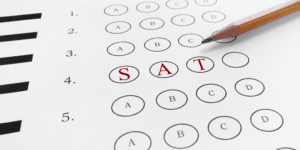Despite the title of this post, the SAT Writing & Language section does not require you to actually write anything. Instead, it tests your ability to pick effective writing using proper grammar, punctuation, and rhetoric from a series of similar answer choices. The overarching thing I remind my students of when going over this section is to stop thinking about “what sounds best” or how you would write the sentence if given that chance. That kind of thinking leads you down the path of subjectivity. On this test, every question has an objectively correct answer. So what does that mean in practice? Read on for the three key SAT Writing & Language strategies.
SAT Writing & Language Strategy #1: Read everything
The most prevalent, and easily avoidable, mistake I see students make on the SAT is not reading carefully and not reading everything. There are a few different ways in which reading everything is important:
- Always read sentences from the very beginning all the way to the very end, especially when answering answer questions.
- In many grammar and punctuation questions, the second half of the sentence will impact the first half. Therefore, if your underlined text is in the middle of the sentence, you never want to stop reading at the end of the underlined portion when testing your answer choices. Always read to the period.
- Read every word on the page, including the title of the passage and sentences or paragraphs that don’t contain questions.
- The title of the passage is easily overlooked, but it will clearly indicate the passage’s main idea. Though you won’t often have explicit main idea questions in this section, some question questions will require an understanding of the main idea. When in doubt, refer to the title.
- As previously mentioned, you will need to have a general understanding of what the passage is saying in order to correctly answer some question questions. These passages are short, so it just doesn’t make sense to skip ahead.
- Always read every single answer choice. This actually applies to every section of the SAT; you can’t catch yourself in a mistake unless you give yourself the chance. Some questions will have multiple answers that may sound good to you, so don’t stop right after you see the first one that you like. Read them all and then pick the best of the four.
SAT Writing & Language Strategy #2: Don’t forget the question
As mentioned in strategy #1, you need to read everything on the page if you want to get the highest SAT score. Though it might sound incredibly obvious, that includes the question part of question questions. You might not believe me when I say it, but forgetting to read the question is an incredibly common mistake among students. Since so many questions contain only answer choices, it’s very easy to ignore the question itself, when it exists, and jump straight to the choices here too.
Reading the question is crucial as it will tell you what it needs you to do. For example, you may be asked to conclude a sentence by giving a benefit to the approach mentioned in the first part of the sentence. Only one answer choice will actually do this! But all of the choices will be grammatically correct, and most will therefore sound good to you.
Writing & Langauge Strategy #3: Think like the test maker, not the test taker
Since over half of the questions on this section don’t contain a question, you might fall into the habit of picking answer choices that “sound right” without stopping to think about why you’re choosing them. Though using your ear is a good idea on this section, it’s best done in conjunction with grammar, punctuation, and SAT logic rules.
Especially when dealing with answer questions, look at the answer choices to see what’s changing between them and ask yourself what the question is testing. Is it comma usage? Subject-verb agreement? Verb tense? Redundancy? Tone? Once you’ve identified what’s going on (and there are often multiple concepts being tested per answer choice), you’ll know what to focus on.
Comparing and contrasting answer choices can also help you more than you might think. For example, if you have multiple disagreement words as choices in a transition word question (such as “however” and “despite this”), neither can be correct as you can’t be asked to choose between them – they mean the same thing! On a punctuation question, knowing that semicolons and commas are mutually exclusive can help you narrow down your choices too. If you have two identically-worded answer choices with a semicolon in one and a comma in the other, the answer will almost always be one or the other.
Putting these strategies to the test
Now that you know the best SAT Writing & Language tips and tricks, you’ll want to keep building your comfort level with this section. If you’d like a helping hand, give us a call today to learn more about how our test experts can help you master the SAT.




